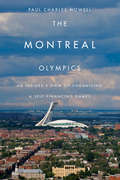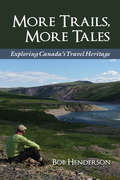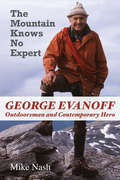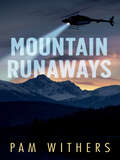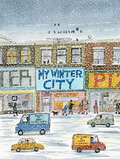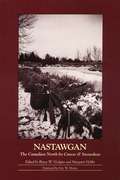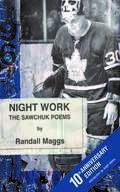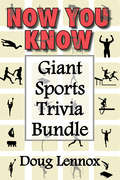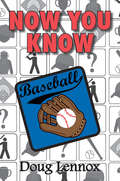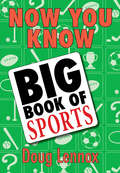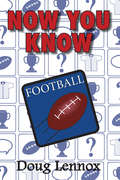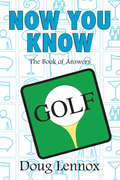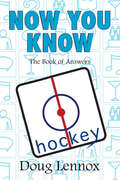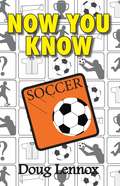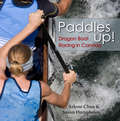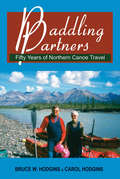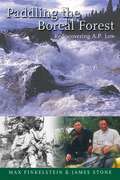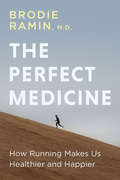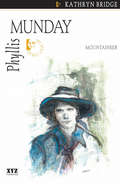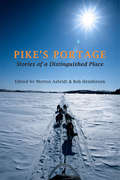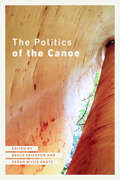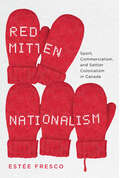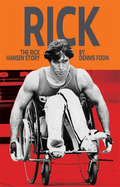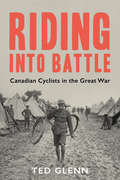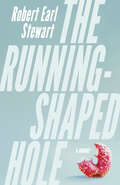- Table View
- List View
Montreal Olympics: An Insider's View of Organizing a Self-financing Games
by Paul Charles HowellPaul Howell, a planning consultant and key player in the Montreal Olympic Organizing Committee, offers an insider's perspective on how a vast, complex, expensive, and highly politicized event was organized within the constraints imposed by limited resources, an unyielding deadline, and intense pressures from international and local special interest groups. He looks at both the struggles and what went uniquely right in Montreal, setting the record straight on operations, political involvement, and finance, including details of the well-publicized multi-billion dollar deficit that was misrepresented by the press and misunderstood by the public for decades.
More Trails, More Tales: Exploring Canada's Travel Heritage
by Bob HendersonAn entertaining book of trivia, anecdotes, and observations about heritage travel in Canada. Inspired by and drawing on Canadian exploration, Bob Henderson’s newest book, More Trails, More Tales, strikes a balance with travel literature, history, geography, anthropology, literature, and philosophy. It will delight outdoor enthusiasts, serious naturalists, educators, and armchair travellers alike. It is essentially a storytelling book, highlighting Canadian stories and examining different aspects of heritage travel in Canada.
The Mountain Knows No Expert: George Evanoff, Outdoorsman and Contemporary Hero
by Mike NashShort-listed for the 2010 Banff Mountain Book Festival Competition The Mountain Knows No Expert epitomizes George Evanoff’s philosophy towards the outdoors, while presenting an intriguing contrast with the man himself. Widely regarded as an "expert," he was a knowledgeable, experienced, and practical outdoorsman, teacher, and mentor, yet ironically lost his life in the mountains in an encounter with a grizzly. Son of a Macedonian immigrant family, George was raised in Alberta, and went on to become a mountaineer, guide, avalanche specialist, and pioneer in ecotourism in British Columbias North Rockies. The many themes embedded in Evanoff’s life experiences encompass self-propelled backcountry travel, outdoor safety, avalanche safety and rescue, ski patrol leader, exploration and discovery, outdoor ethics, and public involvement with respect to land and resource use. George Evanoff was honoured in several tangible ways after his death, culminating in the naming of Evanoff Provincial Park in the Hart Ranges of the Rockies.
Mountain Runaways
by Pam WithersWill their wilderness skills be enough to survive the dangerous Rocky Mountains?First a Canadian Rockies avalanche kills their parents. Then Children’s Services threatens to separate them. That’s when the three Gunnarsson kids decide to run away into the mountains and fend for themselves until the oldest turns eighteen and becomes their legal guardian. Not many would dare. But Jon, Korka, and Aron’s parents ran a survival school.Turns out their plan is full of holes. When food and equipment go missing and illness and injury strike, things get scary. They’re even less prepared for encounters with dangerous animals and a sketchy woods dweller. On top of that, grief, cold, hunger, and sibling infighting threaten to tear them apart, while the search parties are closing in on them. Do Jon, Korka, and Aron really have what it takes to survive?
My Winter City
by James GladstoneA boy, his father and their dog have a perfect day in a snowy city, illustrated by Governor General’s Literary Award winner Gary Clement. A young boy wakes up in the early light of a winter morning, pulls on his boots and mittens, and steps out into the snowy city with his dad. They trudge through the snow, their dog bounding along beside them, then a slushy, steamy bus ride takes them to the tobogganing hill for some winter fun. The boy describes all the sights and sounds of the day, from the frost in Dad’s beard and the snow “pillows” in the park, to the noisy clunking snow plows and the singing buskers they pass on their way home. That night, the boy lies awake under cozy covers, reflecting on the day, as snow blankets the world outside his window. This is winter in the city. Correlates to the Common Core State Standards in English Language Arts: CCSS.ELA-LITERACY.RL.1.3 Describe characters, settings, and major events in a story, using key details. CCSS.ELA-LITERACY.RL.1.7 Use illustrations and details in a story to describe its characters, setting, or events.
Nastawgan: The Canadian North by Canoe & Snowshoe
by Bruce W. Hodgins Margaret HobbsA rich history of Canadian wilderness travel, "an utterly compelling collection," said The Globe and Mail, and "a gem -- it absolutely sparkles," according to Canadian Geographic. Declared by the Canadian Historical Association to be the best book published of its year on the regional history of Canada's North.With essays by William C. James, C.E.S. Franks, George Luste, Margaret Hobbs, John Jennings, Shelagh Grant, Gwyneth Hoyle, Bruce W. Hodgins, Jamie Bendickson, Craig Macdonald, Jean Murray Cole, John Marsh and John Wadland.
Night Work: The Sawchuk Poems - 10th Anniversary Edition
by Randall MaggsA new edition of a hockey saga, wrapping the game's story in the "intense, moody, contradictory" character of Terry Sawchuk, one of its greatest goalies. Denied the leap and dash up the ice, what goalies know is side to side, an inwardness of monk and cell. They scrape. They sweep. Their eyes are elsewhere as they contemplate their narrow place. Like saints, they pray for nothing, which brings grace. Off-days, what they want is space. They sit apart in bars. They know the length of streets in twenty cities. But it's their saving sense of irony that further isolates them as it saves. - from "One of You" In compact, conversational poems, Night Work: The Sawchuk Poems follows the tragic trajectory of the life and work of Terry Sawchuk, dark driven genius of a goalie who survived twenty tough seasons in an era of inadequate upper-body equipment and no player representation. But no summary touches the searching intensity of Maggs's poems. They range from meditations on ancient/modern heroism to dramatic capsules of actual games, in which the mystery of character meets the mystery of transcendent physical performance. Night Work: The Sawchuk Poems is illustrated with photographs mirroring the text, depicting key moments in the career of Terry Sawchuk, his exploits and his agony. This 10th anniversary edition of the book marks both the 50th anniversary of the last time the Leafs won the Stanley Cup and the 100th anniversary of the Leafs as a team. With rich reflections on the book by novelist Angie Abdou and Hockey Night in Canada host Ron MacLean, as well as excerpts from scores of reviews by the likes of Gord Downie and Dave Bidini, this new edition of Night Work is a must-have for lovers of hockey and poetry alike.
Now You Know — Giant Sports Trivia Bundle: Now You Know Golf / Now You Know Hockey / Now You Know Soccer / Now You Know Football / Now You Know Baseball
by Doug LennoxPresenting five books in the popular and exhaustive trivia series. This one’s for the sports buff in the family! Doug Lennox, the world champion of trivia, is back to score touchdowns, hit homers, win the golden boot, and knock in holes-in-one every time with a colossal compendium of Q&A athletics that has all anyone could possibly want to know from archery and cycling to skiing and wrestling and everything in between. Why does the winner of the Indianapolis 500 drink milk in victory lane? Who was the first player ever to perform a slam dunk in a basketball game? Why are golfers’ shortened pants called "plus-fours"? When was the Stanley Cup not awarded? Why does the letter k signify a strikeout on a baseball score sheet? Where is the world’s oldest tennis court? What’s more, Doug goes for gold with a wealth of Winter and Summer Olympics lore and legend that will amaze and captivate armchair fans and fervent competitors alike. Includes Now You Know Golf Now You Know Hockey Now You Know Soccer Now You Know Football Now You Know Baseball
Now You Know Baseball
by Doug LennoxWhile baseball is touted as America’s favourite pastime, everyone will know the score with this grand slam of Q&A that’s sure to be inducted into the Hall of Fame. Doug Lennox hammers it out of the park by filling us in on who’s won the most Cy Young Awards, what the Green Monster is, and the five ways that a player can be called "out." In this treasure trove of baseball lore, you’ll learn all about the leagues and teams that have come and gone, the players who are legends, and the achievements and records that have become the stuff of myth and fable. Where and when did Babe Ruth hit his first professional home run? What major league team was known as the Blue Jays long before a team existed in Toronto? Who were the Bash Brothers? Where was baseball first played? Who wrote the song "Take Me Out to the Ball Game"? Did Fidel Castro try out for the New York Yankees?
Now You Know Big Book of Sports
by Doug LennoxEver wonder where the figure skating terms axel, salchow, and lutz came from? Or why a curling tournament is called a "brier"? And how about a "haymaker" in boxing or a "high five" in any sport? Well, Doug Lennox, the world champion of trivia, is back to score touchdowns, hit homers, and knock in holes-in-one every time with a colossal compendium of Q&A athletics that has all anyone could possibly want to know from archery and cycling to skiing and wrestling and everything in between. What’s more, Doug goes for gold with a wealth of Winter and Summer Olympics lore and legend that will amaze and captivate armchair fans and fervent competitors alike. What do the five Olympic rings and their colours represent? Why does the winner of the Indianapolis 500 drink milk in victory lane? Who was the first player ever to perform a slam dunk in a basketball game? Why are golfers’ shortened pants called "plus-fours"? When was the Stanley Cup not awarded? Why does the letter k signify a strikeout on a baseball score sheet? Where is the world’s oldest tennis court?
Now You Know Football
by Doug LennoxIt’s easy to be a Monday-morning quarterback, but the true football fan has the answers all week long. Doug Lennox, the all-pro of Q&A, leads the drive as he tells us why a touchdown is worth six points, who first decided to pick up the ball and throw it, and how a children’s toy changed the sport’s biggest championship. Along the way we’ll meet players great and not-so-great and encounter the various leagues that have come and gone throughout the world. Why is the sport called "football"? Who first used the term sack? Why did one American president consider banning football? What football team was named after a Burt Reynolds character? Why are footballs shaped the way they are? How many times have NFL and CFL teams squared off? Which came first - the Ottawa Rough Riders or the Saskatchewan Roughriders? Whose Super Bowl ring is a size 25?
Now You Know Golf
by Doug LennoxEverybody seems to be a golfer or at least knows someone who is. The game is one of the world’s most popular sports, and now Doug Lennox, the links pro of Q&A, hits the green with a barrage of golfing trivia on everything from albatrosses and barkies to Vardon grips and zingers. All the titans, male and female, take a swing, including Bobby Jones, Ben Hogan, Sam Snead, Jack Nicklaus, Arnold Palmer, Kathy Whitworth, Vijay Singh, Annika Sorenstam, Michelle Wie, and, of course, Tiger Woods.What is the oldest playing golf course in the world?Where was golf invented?How does the term sandbagger connect golf with criminals?What member of British royalty introducedgolf to Continental Europe?Who was the first female golfer to compete in a major men’s professional match?What type of golf club did astronaut Alan Shepard use on the moon?
Now You Know Hockey: The Book of Answers
by Doug LennoxAs Canadians, we all think we know hockey inside and out, but Doug Lennox, the head referee of Q&A, delivers the score on everything from All-Stars to Zambonis and stickhandles the skinny on who wore the first mask in hockey, how the term hat trick originated, and just where hockey was invented. Along the way, you’ll discover all sorts of fascinating things about the giants of the game, from Jean Beliveau and Sidney Crosby to Gordie Howe and Alexander Ovechkin.Who was the first black player in the NHL?Where did the word deke come from?What was the greatest women’s hockey team of all time?How did the Rocket Richard riot start?Who was the first Russian to play in the NHL?When was the Stanley Cup not awarded?What team beat Canada for the gold medal in the 1936 Winter Olympics?
Now You Know Soccer
by Doug LennoxKnown around the world as football, soccer is the world’s most watched and played sport. Now Doug Lennox, the striker of Q&A, scores with a pitch full of tidbits that delivers the goods on Pelé, Maradona, Beckham, Zidane, and other superstars, as well as the history, traditions, and rules of the game. Doug has compiled a World Cup of trivia about a truly universal phenomenon that has legions of passionate, and sadly sometimes violent, fans. How did soccer originate?, Who was the first soccer player to score a hat trick in a World Cup final? What was the largest attendance ever for a soccer match? What is the "technical area"? Where was the world’s first soccer club formed? What was the first movie ever made about soccer? Where was the first World Cup held? What are the Laws of the Game? What were the 10 worst losses of life in soccer history?
Paddles Up!: Dragon Boat Racing in Canada
by Arlene Chan Susan HumphriesPaddles Up! provides an in-depth look at dragon boating from its beginnings in ancient China to the modern-day prominence of Canadian teams on the international scene, as told in the words of top coaches of men’s and women’s teams, experts and enthusiasts, and sports health professionals across Canada. Contributing writers include Mike Haslam, executive president International Dragon Boat Federation; Matthew Smith, president Dragon Boat Canada; Kamini Jain, Vancouver; Albert MacDonald, Halifax; Jamie Hollins, Pickering; Matt Robert, Montreal; and Jim Farintosh, Toronto. Through legends, history, and traditions, to paddling tips and mental readiness, and from choosing gear to exceptional achievements, a battery of Canadian dragon-boat notables share their considerable knowledge in one authoritative volume.
Paddling Partners: Fifty Years of Northern Canoe Travel
by Bruce W. Hodgins Carol HodginsCarol and Bruce Hodgins began leading canoe trips in 1957 for Camp Wanapitei on Lake Temagami in Northern Ontario, initially to the great rivers of that region and on into Quebec. Their first venture north of 60 found them on the South Nahanni, soon to be followed by the Coppermine River, and by the 1990s their annual tripping took them to the Soper River on Baffin Island. included with their richly descriptive accounts of wilderness travel with groups of people, are kayak adventures in Baja California, Mexico, and the Queen Charlottes, paddling in and near the Everglades and explorations on Heritage rivers in the Maritimes and along the coast of Newfoundland. Few have personally experienced the breadth of wilderness travel in Canada as have the Hodgins husband-and-wife team. Their fifty years as "paddling partners," a legendary achievement, is a story of shared joys, challenges, triumphs and mishaps, delightfully told and augmented by excerpts from daily logs, historical insights and the tidbits of experience gleaned over the years.
Paddling the Boreal Forest
by Max Finkelstein James Stone Becky MasonThe boreal forest of Quebec/Labrador – some of the most rugged and isolated land in Canada – has captivated avid canoeists for generations. In the latter 19th and early 20th centuries, the intrepid A.P. Low of the Geological Survey of Canada spent, in total, more than ten years of his working life surveying the area. Employing Aboriginal canoemen and guides, he travelled by canoe, snowshoe and sailing vessel to map and document much of this vast territory. Challenged by the mystique of this extraordinary Canadian, canoeists Max Finkelstein and James Stone retraced Low’s routes – by their admission, their toughest canoe trip ever! Using archival sources, oral history and personal experience, they tell the story of A.P. Low and, in the process, reveal the environmental issues now facing this much threatened Canadian wilderness.
The Perfect Medicine: How Running Makes Us Healthier and Happier
by Brodie RaminImagine a medicine that could make you live longer, healthier, happier, and stronger. What if that medicine was already right at your feet? Running is the miracle drug that can do all this and more — it is the perfect medicine.Throughout his career, Dr. Brodie Ramin has seen cases of diabetes, hypertension, and anxiety, which he has traced back to inactivity. Now more than ever, people are looking for inspiration and motivation to get fit, change their lives, and improve their overall wellness. In The Perfect Medicine, Dr. Ramin shares with us his discovery that we already have the perfect medicine to treat and prevent these common illnesses and improve our health: running. However, too few people are taking the right dose or using it at all.The Perfect Medicine explores the science of running and exercise and provides advice on how to maximize its benefits and be your best self. After rediscovering the joy of running in his early thirties, Dr. Ramin became fascinated by the activity. This book takes the reader on a personal journey of discovery, traces the evolution of running, shares strategies to get fit and run faster, and shows how exercise can even help people recover from addiction and mental health conditions.
Phyllis Munday
by Kathryn BridgeIn 1924 Phyllis (Phyl) Munday did what no other woman had done before - reached the summit of Mt. Robson. She climbed close to 100 mountains in her lifetime, many of those first ascents. She honed her outdoor skills as a Girl Guide leader and remained active in Guides throughout her life. During the 1920s and 1930s, Phyl and her partner Don Munday pioneered exploration into the heart of the Coast Mountains.
Pike's Portage: Stories of a Distinguished Place
by Morten Asfeldt Bob Henderson"Pike’s Portage plays a very special role in the landscape of Canada’s Far North and its human history. It is both an ancient gateway and the funnel for early travel from the boreal forest of the Mackenzie River watershed to the vast open spaces of the subarctic taiga, better known as the "Barren Lands" of Canada. "This book is a rich and wonderful comopendium of stories about this area and the early white explorers, the Dene guides, the adventurers, the trappers, the misguided wanderers (like John Hornby) as well as the modern-day canoeists who passed this way. For the reader, it provides an absorbing escape into the past and the endless solitude of the northern wilderness." – George Luste, wilderness canoeist, physics professor (University of Toronto), and founder-organizer of the annual Wilderness Canoeing Symposium. "So why do people come to this place, this Pike’s Portage in particular? The call of landscape is potent and these word portraits collected here offer up some of those who have answered. Both subject and writer reveal the complexities of human perception. Some are called by the profound power of inherited cultural meaning, while a huge dose of imagination draws others from far away. These worlds seldom truly meet, even in a place as busy as this, but whether it is homeland or wilderness, human histories are recorded in footprints, place names, and memory, and here we stand with a magnificent view, marvelling at it all." – Susan Irving, Curatorial Assistant, Prince of Wales Northern Heritage Centre, Yellowknife, NWT
The Politics of the Canoe
by Bruce Erickson Sarah Wylie KrotzPopularly thought of as a recreational vehicle and one of the key ingredients of an ideal wilderness getaway, the canoe is also a political vessel. A potent symbol and practice of Indigenous cultures and traditions, the canoe has also been adopted to assert conservation ideals, feminist empowerment, citizenship practices, and multicultural goals. Documenting many of these various uses, this book asserts that the canoe is not merely a matter of leisure and pleasure; it is folded into many facets of our political life. Taking a critical stance on the canoe, The Politics of the Canoe expands and enlarges the stories that we tell about the canoe’s relationship to, for example, colonialism, nationalism, environmentalism, and resource politics. To think about the canoe as a political vessel is to recognize how intertwined canoes are in the public life, governance, authority, social conditions, and ideologies of particular cultures, nations, and states. Almost everywhere we turn, and any way we look at it, the canoe both affects and is affected by complex political and cultural histories. Across Canada and the U.S., canoeing cultures have been born of activism and resistance as much as of adherence to the mythologies of wilderness and nation building. The essays in this volume show that canoes can enhance how we engage with and interpret not only our physical environments, but also our histories and present-day societies.
Red Mitten Nationalism: Sport, Commercialism, and Settler Colonialism in Canada
by Estée FrescoWhen Canada hosted the 1976 Montreal Olympics, few Canadian spectators waved flags in the stands. By 2010, in the run-up to the Vancouver Olympics, thousands of Canadians wore red mittens with white maple leaves on the palms. In doing so, they turned their hands into miniature flags that flew with even a casual wave.Red Mitten Nationalism investigates this shift in Canadians’ displays of patriotism by exploring how common understandings of Canadian history and identity are shaped at the intersection of sport, commercialism, and nationalism. Through case studies of recent Canadian-hosted Olympic and Commonwealth Games, Estée Fresco argues that representations of Indigenous Peoples’ cultures are central to the way everyday Canadians, corporations, and sport organizations remember the past and understand the present. Corporate sponsors and games organizers highlight selective ideas about the nation’s identity, and unacknowledged truths about the history and persistence of Settler colonialism in Canada haunt the commercial and cultural features of these sporting events. Commodities that represent the nation – from disposable trinkets to carefully curated objects of nostalgia – are not uncomplicated symbols of national pride, but rather reminders that Canada is built on Indigenous land and Settlers profit from its natural resources. Red Mitten Nationalism challenges readers to re-evaluate how Canadians use sport and commercial practices to express their patriotism and to understand the impact of this expression on the current state of Indigenous-Settler relations.
Rick: The Rick Hansen Story
by Dennis FoonFifteen-year-old Rick Hansen is confident, outgoing, and the star of his high-school basketball team. He has his whole life planned out, until a tragic accident severs his spinal cord, leaving him in a wheelchair. Rick's accident forces him to adapt his positivity to deal with his new life, while helping to strengthen the relationship with his guilt-stricken best friend. Refusing to be put at a disadvantage, Rick conquers the challenges presented to him with a smile and changes the definition of what it means to be disabled. Based on the true story of the man who inspired millions with his Man In Motion World Tour, Rick is a triumphant play that showcases the importance of optimism and perseverance, encouraging audiences to make their own paths to change the world.
Riding into Battle: Canadian Cyclists in the Great War
by Ted GlennThe untold story of how Canadian Cyclists came into their own during the Hundred Days campaign of the Great War. Canada’s Cyclists spent most of the First World War digging trenches, patrolling roads, and delivering dispatches. But during the Hundred Days campaign at the end of the Great War, Canada’s cycling troops finally came into their own. At Amiens, Cambrai, and especially the Pursuit from the Sensée, the Cyclists made pioneering contributions to the development of the Canadian Corps’s combined arms strategy and mobile warfare doctrine, all the while exhibiting the consummate professionalism the Corps became renowned for.
The Running-Shaped Hole
by Robert Earl StewartA searching, self-deprecating memoir of a man on his way to eating himself to death before discovering the anxiety and fulfillment of distance running.“Uplifting, emotional, and just plain hilarious, The Running-Shaped Hole may even inspire you to put down your fork and pick up those running shoes.” — JAY ONRAIT, TSN host and broadcasterWhen Robert Earl Stewart sees his pants lying across the end of his bed, they remind him of a flag draped over a coffin — his coffin. At thirty-eight years old he weighs 368 pounds and is slowly eating himself to death. The only thing that helps him deal with the fear and shame is eating. But one day, following a terrifying doctor’s appointment, he goes for a walk — an act that sets The Running-Shaped Hole in motion. Within a year, he is running long distances, fulfilling his mother's dying wishes, reversing the disastrous course of his eating, losing 140 pounds, and, after several mishaps and jail time, eventually running the Detroit Free Press Half-Marathon.At turns philosophical and slapstick, this memoir examines the life-altering effects running has on a man who, left to his own devices, struggles to be a husband, a father, a son, and a writer.
